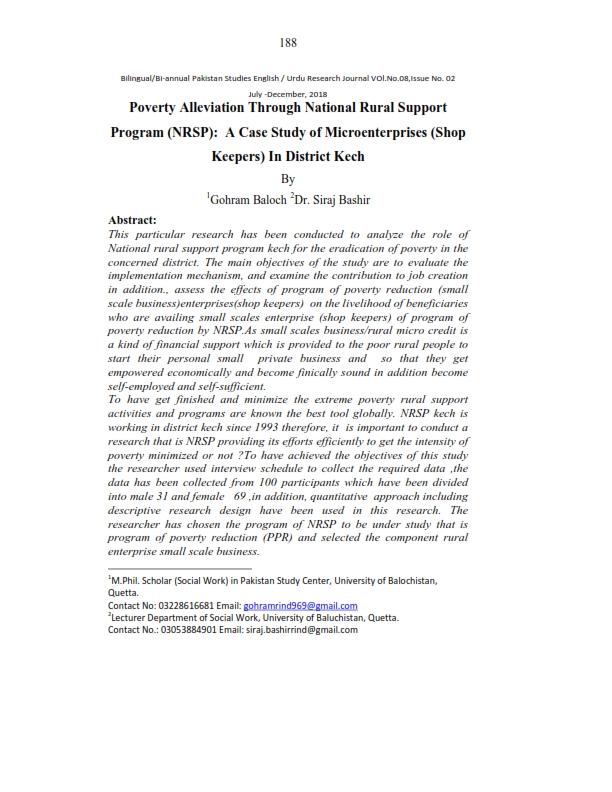Poverty Alleviation Through National Rural Support Program (NRSP) A Case Study of Microenterprises (Shop Keepers) In District Kech
Keywords:
the role of National rural support program, eradication of poverty, implementation mechanismAbstract
This particular research has been conducted to analyze the role of
National rural support program kech for the eradication of poverty in the
concerned district. The main objectives of the study are to evaluate the
implementation mechanism, and examine the contribution to job creation
in addition., assess the effects of program of poverty reduction (small
scale business)enterprises(shop keepers) on the livelihood of beneficiaries
who are availing small scales enterprise (shop keepers) of program of
poverty reduction by NRSP.As small scales business/rural micro credit is
a kind of financial support which is provided to the poor rural people to
start their personal small private business and so that they get
empowered economically and become finically sound in addition become
self-employed and self-sufficient.
To have get finished and minimize the extreme poverty rural support
activities and programs are known the best tool globally. NRSP kech is
working in district kech since 1993 therefore, it is important to conduct a
research that is NRSP providing its efforts efficiently to get the intensity of
poverty minimized or not ?To have achieved the objectives of this study
the researcher used interview schedule to collect the required data ,the
data has been collected from 100 participants which have been divided
into male 31 and female 69 ,in addition, quantitative approach including
descriptive research design have been used in this research. The
researcher has chosen the program of NRSP to be under study that is
program of poverty reduction (PPR) and selected the component rural
enterprise small scale business.
References
Abrar ul haq, M.Kashif,Ayub.Muhammad Imadad Ullah.(2015).Micro –
level Determinants of Rural poverty in Pakistan: International
Journal of Scientific and Research publications, volume.
Afroz, G (2007). Role of Co member in promoting primary education for
their children.
Ahmad, V. (2010). Global Economic Crisis & Poverty in Pakistan.
International Journal of Micro simulation, 3(1), 127-129.
Akram, M., & Hussain, I. (2011). The role of microfinance in uplifting
income level: A study of district Okara-Pakistan. Interdisciplinary
Journal of Contemporary Research in Business,
Alam, M. Raza Ullah. Ali Iqtidar Mirza. Waqar Saleem. Mehboob Elahi.
& Hamid Sultan (2014). Impact of Microcredit Scheme on Socioeconomic Status of Farmers (A case study of PRSP in District
Gujranwala) A Research Journal of South Asian Studies Vol. 29,
No. 1
Asad-uz-Zaman, M. (1997). Role of Micro-credit in poverty Alleviation in
Bangladesh: A Comparison on NGO and Government Initiatives,
R. Rahman (Ed) Poverty and Development: The Bangladesh
perspective. Dhaha, Bangladesh: BIDS.
Chaudhry, I. S. (2003). An empirical analysis of the determinants of rural
poverty in Pakistan: A case study of Bahawalpur district with
special reference to Cholistan., The Islamia University of
Bahawalpur, Pakistan.
Clark J. (1991). Democratizing Development: The Role of Voluntary
Organization. London, England: Eartscan.
Dr. Rakhshinda Perveen (2013) SuccessfulSocial Entrepreneur Heart and
Head together,published by Economic Freedom Network Pakistan
(EFN),Supported by Friedrich-Naumann-Stiftung für die Freiheit
(FNF), Islamabad – Pakistan.
DWAN,(2004) Role of NGOs in the social sector,Nov 08.
GurungAnup, Om Prakash Gurung , Rahul Karki, Rajesh Bista (2011).
Hassan A.B.M Enamol (2015) NGOs and Their Implications in Promoting
Social Development in Bangladesh: An Overview. Sociology and
Anthropology 3,
Hulme, D., & P. Mosley (1996). Finance against poverty. London:
Routledge.
Impact of Non-Governmental Organizations in the Rural Community
Development: A Case Study from the Trans-Himalayan Region of
Nepal, International Journal of Applied Sociology (1):
Iqbal, Z. Shahid Iqbal & Muhammad Ahmad Mushtaq (2015). Impact of
Microfinance on Poverty Alleviation: The Study of District
Bahawal Nagar, Punjab, Pakistan.Management and Administrative
Sciences Review, Volume 4, Issue 3.p.6-7.
Jivani Razeen UPenn, Wharton (2010). What are the Impacts of NonGovernmental?
Jivani,R.UPenn, Wharton(2010) What are the Impacts of NonGovernmental
Kabir. S, Uddin Haider (2013). The Impacts of NGOs on the SocioEconomic Situation of the Poor: A Case Study in Rajshahi City:
Bangladesh, International Journal of Community Development,
Vol. 1, No. 1,
Kitamura, Y. (2007). “The political dimensions of international
cooperation in education: mechanisms of global governance to
promote Education for All”. In: International Perspectives on
Education and Society,
Malik, ZK.Samra Kiran & Muhammad Alam (2013). The Role of Benazir
Income Support Programme in Poverty Reducaiton:A case study of
the selected villages in District Peshawar. City university Research
Journal . City university Research Journal , Volume 03.
Mohammad Arifujjaman Khan, Mohammed Anisur Rahaman, (2007).
Impact of Microfinance on Living Standards, Empowerment and
Poverty Alleviation of Poor People: A Case Study on Microfinance
in the Chittagong District of Bangladesh.Umeå School of Business
(USBE),Department of Business Administration.
Muhammad, S.D. (2010). Microfinance Challenges and Opportunities in
Pakistan. European Journal of Social Sciences, Vol. 14
Nawaz, A. (2010). Micro-finance and poverty education: Evidence from a
village study in Bangladesh. Journal of Asian and African Studies.



